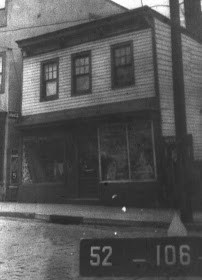Once upon a time it was a street lined by shops with apartments over head and even a synagogue. Just off it were detached houses and a church. By the early eighties, a large stretch of the old buildings were demolished and replaced with attached townhouses. Today, Jersey Street is a little better than it was in the eighties and recently a few new businesses have opened. No matter what happens, Jersey Street will never be the mighty commercial strip it once was. As usual, the removal of mixed-use building and their replacement with purely residential housing projects utterly changed the fundamentals of the area. A ton more people were packed into the area, but a great number of stores were eliminated, limiting the choices residents would have.
Saturday, September 02, 2017
Jersey Street: Part One Northwest side between Richmond Terrace and Pauw Street
When I was a kid, Jersey Street had a reputation as a dangerous place. Much of that was overblown and attributable to racism. It wasn't the safest place on the Island, though. Once it had been a heavily trafficked commercial and residential strip, but my childhood, the projects and changing demographics had dimmed Jersey Street considerably.
Once upon a time it was a street lined by shops with apartments over head and even a synagogue. Just off it were detached houses and a church. By the early eighties, a large stretch of the old buildings were demolished and replaced with attached townhouses. Today, Jersey Street is a little better than it was in the eighties and recently a few new businesses have opened. No matter what happens, Jersey Street will never be the mighty commercial strip it once was. As usual, the removal of mixed-use building and their replacement with purely residential housing projects utterly changed the fundamentals of the area. A ton more people were packed into the area, but a great number of stores were eliminated, limiting the choices residents would have.
Once upon a time it was a street lined by shops with apartments over head and even a synagogue. Just off it were detached houses and a church. By the early eighties, a large stretch of the old buildings were demolished and replaced with attached townhouses. Today, Jersey Street is a little better than it was in the eighties and recently a few new businesses have opened. No matter what happens, Jersey Street will never be the mighty commercial strip it once was. As usual, the removal of mixed-use building and their replacement with purely residential housing projects utterly changed the fundamentals of the area. A ton more people were packed into the area, but a great number of stores were eliminated, limiting the choices residents would have.









This blog is near and dear to my heart. I was born and raised on Layton Ave. I hung out at Mahoney Playground for a good portion of my youth. This all took place during the 40's, 50's and 60's. Then the rug was pulled out from under our feet when the City forced us out. The saying "you can't go back" really hits the mark for me because the is no back to go to.
ReplyDeleteI'll be waiting impatiently for the next chapters in documenting Staten Island's north shore. Hopefully you'll have many more pictures of my old neighborhood.
--
bobC
Your comment almost brought me to tears. I was inspired to document the neighborhoods destroyed for the Stapleton, West Brighton, and Jersey Street Projects because my supervisor was forced out of the home her family rented in Stapleton in the early 60s. From the research I've done so far, an argument could be made that Stapleton really was "blighted," but New Brighton seems to have been a totally different, bogus case.
ReplyDelete